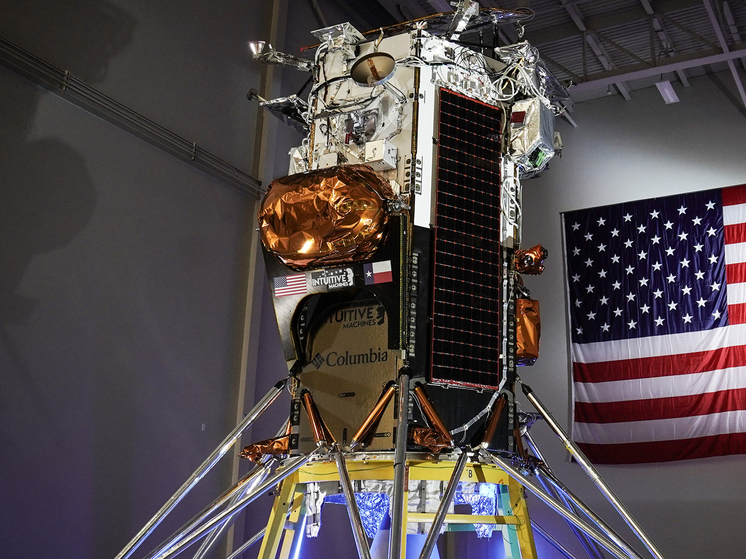The South Pole of the Earth's satellite became fatal for researchers from different countries
In the area of the South Pole of the Moon, the American Nova-C was added to the three vehicles that had arrived there earlier from Russia, India and Japan. However, like its predecessor from Japan, it fell on its side and does not provide the full information expected from it. At first glance, an unsuccessful mission is still presented overseas as a victory. In a conversation with the head of the laboratory of nuclear physics instruments of the Space Research Institute of the Russian Academy of Sciences, Maxim Mokrousov, we tried to understand what this victory was about.

To begin with, it would be useful to remember that our Luna-25 claimed to be the first vehicle to land on the South Pole of the Moon back in August 2023. She, of course, achieved it, but not in the way we would have liked — Luna 25 crashed due to an error by the programmers, who were unable to correctly place it into the landing orbit. The inoperative device is now located in the Ponteculan G crater.
Following us, in September, the Indian apparatus of the Chandrayaan-3 mission arrived in the region of the South Pole of the Moon and softly landed, which managed to successfully complete its mission. The Japanese SLIM landed as early as January 2024 near the tiny Shiori crater in the eastern part of the Kirill crater. SLIM became the first Japanese mission to soft-land on the lunar surface. This was its main task; the landing accuracy was less than 100 meters at the planned landing site. However, after that the device could not stay on its “legs” and fell on its side. As a result, its solar panels, which turned out to be turned away from the Sun, were unable to recharge the batteries — the device “fell asleep.”
The Nova-C module of the American company Intuitive Machines (the first private company to send a device to the Moon) arrived at its destination — in the area of the Malapert A crater, which is 300 km from the South Pole of the Moon, on February 23. This was the first landing of a module from the United States in more than half a century, but… It, like the Japanese SLIM, fell on its side.
— The American situation is very similar to the Japanese one. Both devices reached the final stage of landing (unlike our Luna-25). That is, they successfully slowed down in orbit in the desired area, successfully verticalized and successfully descended and braked during descent. The only thing they failed to do was completely extinguish the horizontal component of the speed, so when they touched, they fell, explains Maxim Mokrousov.
— I will do this using the example of the Americans. They entered the desired orbit. Then, before reaching the desired point, the device turned backwards — such a maneuver is necessary to perform a braking impulse with the engine forward. In fact, they reduced the speed as much as possible, and then the device began to descend along a ballistic trajectory due to gravity alone. At that moment, when the device began to turn with its engine towards the Moon to dampen the vertical speed, it was necessary to hold it not completely vertically, but at a slight inclination, against the horizontal speed vector; they probably did. It had to be extinguished very well. But, alas, it turned out to be insufficiently extinguished, and as a result, when touching the surface, the apparatus overturned.
— In any case, you need to understand that private capital in any such mission constitutes only a part of the invested funds. If we take the work of Mr. Musk as an example, it becomes clear that the state allocates up to 80% of the funds for all of his grandiose projects. Of course, in the States they are trying to show that they are actively developing the private space business, but we need to understand how this is done in reality.
— Not really, but I suspect that overall much more was spent on the project, despite the fact that it was basically just a landing module and there was almost no science there. For comparison, take the most expensive project in history — MSL (Mars Science Laboratory). This is a NASA program during which the third generation rover Curiosity was successfully delivered to Mars and is being operated. Its cost was (according to Wikipedia) 2.5 billion dollars.
— Three years is very fast. If in Russia all the classic bureaucratic obstacles, military acceptance, etc., were removed, then we would be able to create a device in 3 to 5 years.
“I don’t know how profitable this method was.” The Americans have a good saying: “Cheap, reliable, fast — choose any two” — “Cheap, reliable, fast — choose any two.” In this case, they chose speed, but I don’t think it was cheap. In any case, they are great for not being afraid to take risks and test new technical approaches to the production of spacecraft.
— Yes, we had the shortest flight pattern. But it also turned out to be the most risky, which did not allow our specialists to make any adjustments during the flight. It is possible that we will also seriously think about a longer route to the Moon in the Luna-27 mission.
— The devices are usually designed to land correctly, as planned, that the antennas will be directed where they need to be. I’m generally surprised that the Americans even received some initial telemetry from an inverted spacecraft. But at the same time, both they and the Japanese will soon run out of batteries, and the devices, from one day to a week, may “fall asleep” irrevocably.


